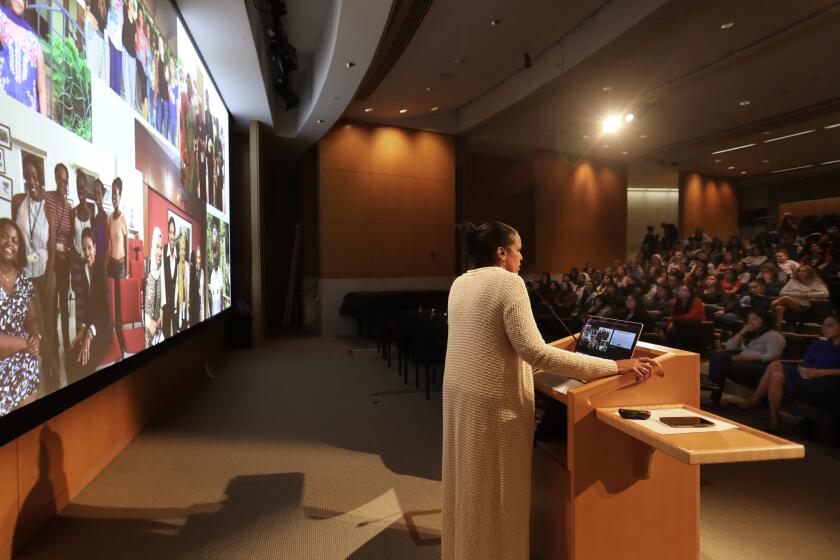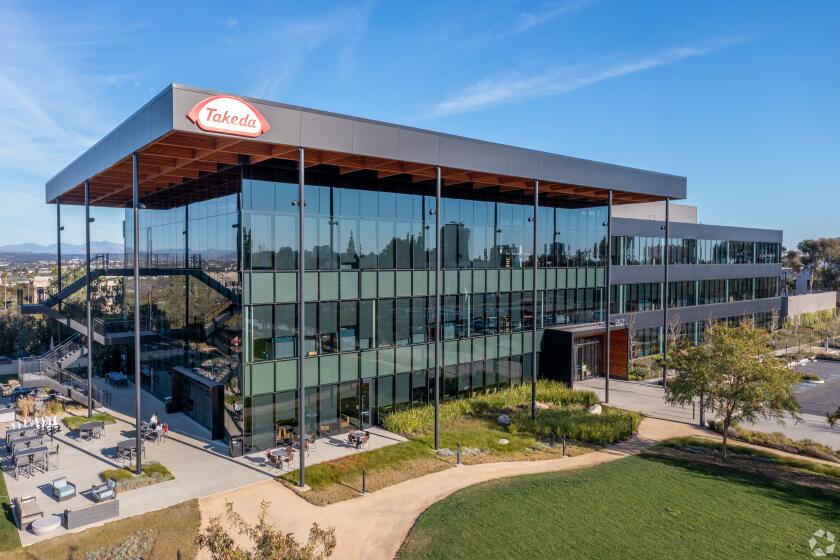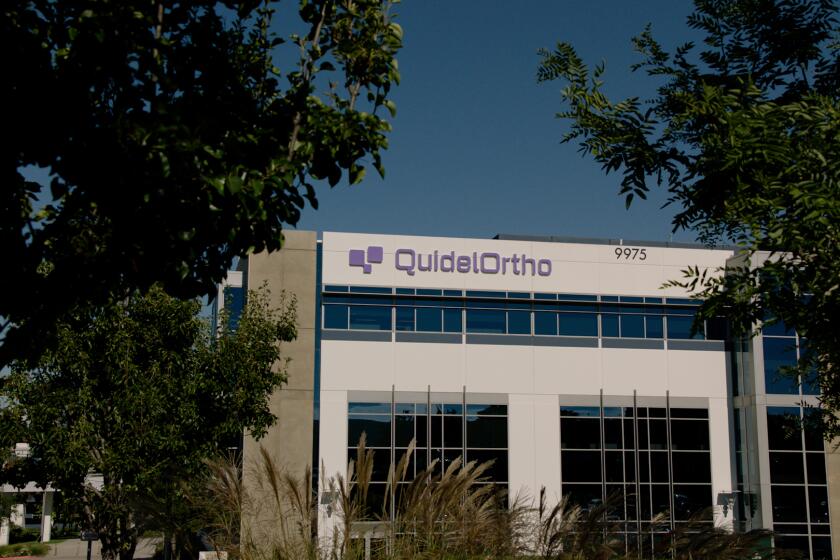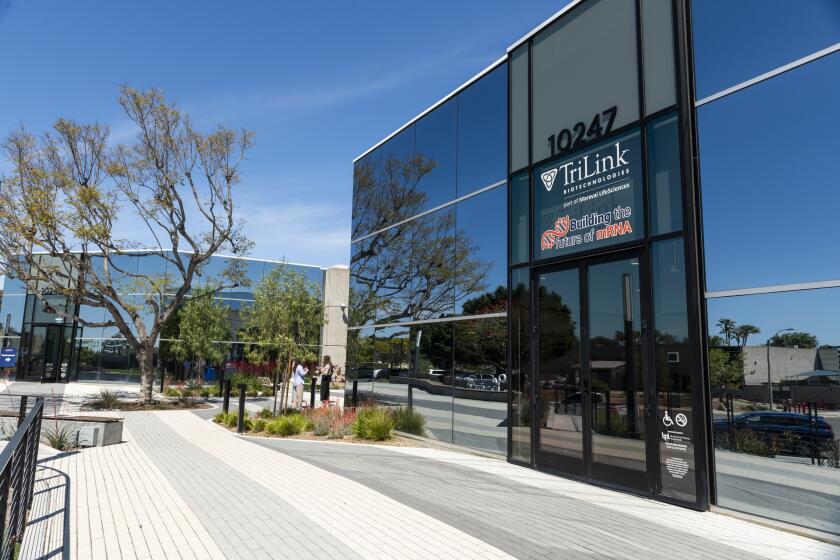Macular degeneration: Incurable, but progress being made
For nearly 30 years, Marjorie Basnight has coped with fading vision.
In the mid-1980s, she was diagnosed with “dry” macular degeneration. The disease slowly damages the macula, the part of the retina that’s in the central field of vision. The macula provides the sharpest vision and color perception.
About 15 years ago, Basnight noticed a rapid deterioration in her vision.
She had developed “wet” macular degeneration as well; it’s caused by blood vessels growing in front of the retina. These blood vessels leak fluid, distorting images.
“If I looked at a venetian blind, instead of being straight it would be wavy,” said Basnight, now 91 and living in Solana Beach.
The deterioration continues, restricting Basnight’s activities. She hasn’t been able to drive in many years, and can’t recognize faces without great effort.
Age-related macular degeneration, or AMD, is estimated to affect up to 15 million Americans. There is no cure, because the retinal cells destroyed by the disease don’t regenerate. The good news is that in recent years, drugs that can slow or halt “wet” macular degeneration, the most damaging kind, have reached the marketplace.
While there’s little in the way of treatment for “dry” macular degeneration, medications for this disease are now in clinical trials. And further down the road, researchers are studying how to restore vision by replacing retinal cells through stem cell therapy.
Drugs targeting “wet” AMD inhibit angiogenesis, the growth of new blood vessels. They include Genentech’s Lucentis and Avastin — the latter produced at the company’s manufacturing facility in Oceanside — and Regeneron’s Eylea.
Angiogenesis drugs became famous for their use in cancer, championed by the late oncology researcher Judah Folkman. These medications can actually cause the abnormal blood vessels to disappear if given in time, said Dr. Anne Hanneken, a Scripps Health ophthalmologist who is Basnight’s doctor and also studies macular degeneration at The Scripps Research Institute.
Basnight’s macular degeneration progressed to an advanced degree before drugs such as Avastin and Lucentis came on the scene, so she can’t benefit from them. But patients in the early stages of the disease often get dramatic relief, said Hanneken, who in medical school studied under Folkman.
“He was constantly encouraging all of the medical students who went through his laboratory to pursue ophthalmology, because he felt the greatest impact of an angiogenesis inhibitor would be in the field of eye disease,” Hanneken said.
The ‘wet’ version
Despite Folkman’s push, cancer became the first priority for angiogenesis drugs. The Food and Drug Administration approved Avastin for cancer in 2004, while Lucentis, related to Avastin, was approved for “wet” AMD in 2006. But Avastin is far cheaper and about as effective as Lucentis, so doctors often use Avastin off-label for macular degeneration.
Eylea was approved in 2011. In addition, various steroids are used because they also inhibit angiogenesis. The medications don’t work in all patients, so biotech and drug companies are continuing to develop other treatments.
This month, Japan’s Santen Pharmaceutical signed a deal to test a drug from San Diego’s Tracon Pharmaceuticals for “wet” macular degeneration. Tracon is already testing the drug, TRC105, for kidney cancer.
Cancers often develop “escape pathways” that thwart angiogenesis drugs, said Dr. Charles Theuer, Tracon’s president and chief executive. So results should be better by using multiple angiogenesis treatments that target different mechanisms, he added.
Drugs such as Avastin inhibit VEGF, or vascular endothelial growth factor. TRC105 targets a different angiogenesis-promoting molecule, endoglin. Tracon is testing its medication in clinical trials, in combination with Avastin and another drug that inhibits VEGF.
The ‘dry’ version
For “dry” macular degeneration, various therapies are being tested, including the use of stem cells. One clinical trial is recruiting patients to try injections of stem cells taken from their own fat. The trial is taking place at the Hollywood Eye Institute in Cooper City, Fla. Information can be found by searching for NCT02024269 at clinicaltrials.gov.
Another trial is examining use of an implanted capsule that releases a drug to nourish retinal cells. That experiment, which is not yet recruiting patients, is expected to take place at several locations including the Jules Stein Eye Institute in Los Angeles. It can be found by searching for NCT01949324 at clinicaltrials.gov.
Kang Zhang, chief of ophthalmic genetics at UC San Diego, is studying AMD from several angles. He’s investigating genetic variants associated with the disease to better understand how it develops, along with angiogenesis inhibitors for “wet” AMD.
“People at the end stage of end-stage macular degeneration have scar tissue with a loss of photoreceptor cells, so stem cell therapy is the only hope for them,” Zhang said.
For those patients, Zhang is studying how to regenerate an entire retina. One approach is to use 3-D “bioprinting” of cells to assemble a retina. Zhang said he and his colleagues are attempting to re-create the embryonic environment in which retinas naturally grow.
“Because the retina is a three-dimensional structure, we have to use ‘bioprinting’ to lay down scaffolds,” Zhang said. His team is working with a variety of animal and human cells.
Diagnosis, prevention
Distortion in vision is a warning sign of AMD, said Hanneken, with the two Scripps groups. The distortion, which may appear in one eye, makes straight lines look crooked.
“A traffic pole or stop sign may have a bend in it, or they may just notice blurred vision,” she said. “They may develop significant vision loss if they’ve developed a hemorrhage under their retina.”
That abrupt loss of vision is why “wet” AMD is considered more worrisome than dry AMD, which is by far the most common form of macular degeneration. However, as with Basnight’s case, “dry” macular degeneration can progress into the “wet” version.
The rate of that progression can be reduced by nearly 30 percent over five years with certain mineral supplements and vitamins, according to a recent clinical study by the National Eye Institute called AREDS2.
“We recommend the combination of vitamins, minerals and lutein, which is a carotenoid,” Hanneken said. Lutein builds up as a pigment in the retina, and is thought to help reduce macular disease, although how it does so is unknown.
Also recommended: Relatively high consumption of fish, because diets rich in fish are associated with a lower rate of macular degeneration. Smoking cessation also is a major positive factor. And keeping levels of cholesterol and other fats associated with heart disease under control helps, Hanneken said.
Learning to cope
Although there’s no treatment yet for patients like Basnight, she manages by making various life adaptations. Some are mental tricks: Since she can’t easily recognize faces, Basnight has memorized cues such as people’s manner of walk and their clothes.
She also relies on technology, such as a magnifying machine that enlarges the view of what is put under it. This setup enables Basnight to read books and papers, and to examine whatever is placed under the device.
“I couldn’t live without that,” she said. “That’s almost a miracle.”
Perhaps most importantly, Basnight can rely on a support network.
“I get along quite well,” she said. “My family is very supportive of me. So far, so good, I guess you could say. But I don’t know what the future holds. That’s the part that worries me.”
Get U-T Business in your inbox on Mondays
Get ready for your week with the week’s top business stories from San Diego and California, in your inbox Monday mornings.
You may occasionally receive promotional content from the San Diego Union-Tribune.







